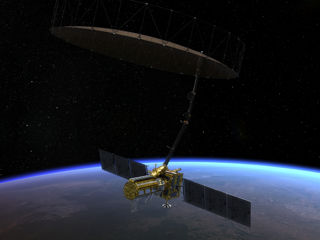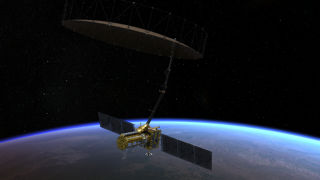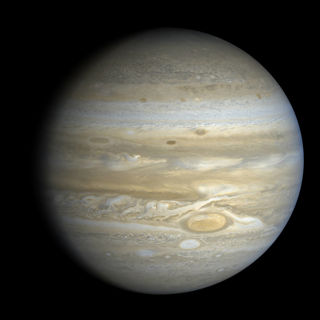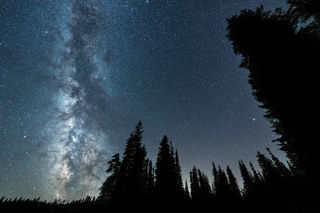
What's Happening in Space: July 2025
- 1st Jul 2025
- Author: Dhara Patel
A summary of space events through the month
The National Space Centre's Space Expert Dhara Patel joins us with her regular overview of some notable space and science events coming up in the weeks ahead...
Throughout July – spot the International Space Station
There may be sightings throughout July to spot the International Space Station (ISS) moving across the sky. Download NASA’s Spot the Station app using the App Store or Google Play to find out when and where to spot the largest artificial satellite overhead. It’ll look like a bright star moving relatively quickly across the sky (generally from west to east) and will be visible to the naked eye. There are multiple sightings during the first week of July from Leicester, though you’ll have to wait until the very late evening or rise in the early hours of the morning to spot it.
4th July – Mercury at greatest eastern elongation
Because Mercury orbits closer to the Sun than Earth, it always appears quite close to the Sun in the sky being lost in its glare most of the time. However, Mercury will be at its furthest separation from the Sun on 4 July when it reaches greatest eastern elongation, making it a great time to try and spot the Sun’s closest planet. Look to the southwest as the Sun sets – it will be very close to the horizon, so you’ll need a good clear view without tall buildings and trees. Find out more about greatest elongations in our astronomical phenomena blog written by David Southworth in the National Space Centre (NSC) Education Team.
10th July – full moon (21:36)
Known as the Buck moon (according to the old Farmers’ Almanac), this month’s full moon is named after bucks (male deer) that would start to regrow their antlers at this time of year. Check out the Full Moon: Full Facts blog written by Mike Darch in the NSC Education team to find out more.

16th July – NISAR mission launch
The NISAR satellite, NASA-ISRO Synthetic Aperture Radar, is a joint mission by the American and Indian space agencies. Delayed from last month, it is now scheduled to launch at 12:30 on 16 July on a GSLV Mk II rocket from the Satish Dhawan Space Centre in India. The mission will map the elevation of the Earth’s land and ice masses up to half a dozen times a month, with a resolution of 5-10 metres. It will use radar pulses that are directed at the Earth, reflected off its surface, and then detected by the satellite, to create high resolution images of our planet’s surface. And by doing so, it will help us better understand some of the Earth’s most complex natural processes like ice sheet collapse and natural disasters such as landslides and tsunamis. Find out more about the NISAR satellite in this blog by Ed Kellond-Turner in the NSC Education team.
16th July – Moon and Saturn close in the sky
Look for the waning gibbous moon near Saturn during the early morning of 16 July before sunrise in the south-eastern sky. The Moon will be in conjunction (sharing the same right ascension – coordinate) with Saturn in the morning, though daylight will drown out the light from the ringed planet, so the best time to spot the duo close together is a short while before that - during the early hours of 16 July around 3:00. Saturn will sit just below and to the left of the Moon and the pair will be visible to the naked eye, but clear views without tall buildings and trees will help you spot them more easily. Check out the astronomical phenomena blog linked above to find out more about close approaches and conjunctions.
21st/22nd July – Moon and Venus close in the sky
Look for the thin waning crescent moon near Venus during the early morning of 22 July before sunrise in the northeastern sky. Venus will appear like a bright star and the Moon will sit to its left. The Moon will be in conjunction (sharing the same right ascension – coordinate) with Venus on the evening of 21 July when both the Moon and Venus will be below the horizon. Instead, the best time to spot the pair close together is around 3:30 on 22 July, when they creep above the north-eastern horizon but before the Sun rises and daylight drowns them out. They’ll be visible to the naked eye, but clear views without tall buildings and trees will help you spot them more easily especially as they’ll be low on the horizon. You can also try spotting the pair close together on the morning of 21 July, but the Moon will sit higher in the sky above Venus at this time. Check out the astronomical phenomena blog linked above to find out more about close approaches and conjunctions.

23rd July – Moon and Jupiter close in the sky
The extremely thin waning gibbous moon will be observable beside Jupiter during the early morning of 23 July before sunrise in the northeastern sky. The Moon will be in conjunction (sharing the same right ascension – coordinate) with Jupiter just after sunrise and daylight will drown out the light from the Solar System’s largest planet, so the best time to spot the duo close together is a short while before that - around 4:00. Jupiter will sit just below and to the right of the Moon and the pair will be visible to the naked eye, but you will need clear views without tall buildings and trees will help you spot them. Check out the astronomical phenomena blog linked above to find out more about close approaches and conjunctions.
24th July - new moon (20:11)
The new moon will occur in the constellation of Cancer. The lack of moonlight interference provides a great time to try and view deep sky objects (especially with the aid of binoculars and telescopes). We have a blog on Moon phases written by Mike Darch in our Education team.
28th July – Moon and Mars close in the sky
Look for Mars positioned beside the Moon during the evening of 28 July in the western sky. The waxing crescent moon will be in conjunction (sharing the same right ascension – coordinate) with Mars around 20:45 but the skies may not yet be dark enough to spot the pair. Try and spot them in close proximity a short while later as the sun begins to set and the sky begins to darken – but don’t wait too long as they’ll set around 22:00. They will be visible to the naked eye - Mars will appear as a red point of light sitting slightly above and to the right of the Moon. Check out the astronomical phenomena blog linked above to find out more about close approaches and conjunctions.

30th July – peak of the Delta Aquariid meteor shower
The Delta Aquariids is an average shower, ~ 15-20 meteors per hour at its peak, produced by dust left behind by comet 96P/Machholz. The peak isn’t clearly defined but 30 July is likely the best time to observe and catch the peak of this meteor shower. Whilst the maximum rate will likely occur in the early evening of 30 July, you’ll have to wait for the skies to darken so it’s best viewed after midnight. The waxing crescent moon will set in the early evening so there won’t be moonlight interfere to hamper your meteor-gazing efforts, but it’s still worth viewing from as dark a location as possible. To spot the meteors find an open location with clear views of the horizon and face in a southeasterly direction looking towards the constellation of Aquarius where the radiant lies, but scan the entire starry canvas above using your eyes, as meteors can appear anywhere in the sky. Check out the Delta Aquariid Meteor Shower 2025 blog to find out more.
31st July – SpaceX Crew-11 launch
The eleventh crewed operational flight of a Crew Dragon spacecraft to the International Space Station as part of NASA’s Commercial Crew Program includes NASA astronauts Commander Zena Cardman and Pilot Mike Fincke along with Mission Specialists Kimiya Yui of Japan's JAXA and Oleg Platanov of Russia's Roscosmos. They are scheduled to launch on board the Crew Dragon Endeavour spacecraft atop a SpaceX Falcon 9 rocket from Kennedy Space Centre no earlier than 17:00 (UK time) on 31 July. During their 6-month stint to the ISS, the crew will conduct scientific investigations and technology demonstrations to help prepare humans for future missions to the Moon, as well as benefit people on Earth. Having launched in March 2025, Crew 10’s Anne McClain, Nichole Ayers, Takuya Onishi and Kirill Peskov will return to Earth on their Crew Dragon spacecraft, Endurance, in August shortly after Crew-11’s launch and a period of handover.
Please note: As this summary is created at the end of the month before, dates (especially launch dates) can often change or be updated, so this content may become outdated - we always recommend checking on the relevant organisation's pages.
